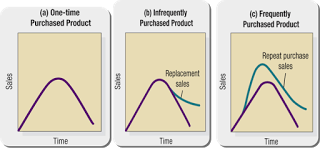A business
analysis is important in forecasting future performance and evaluating the new
concept’s business potential (Palepu & Healy, 2008; Kotler & Armstrong,
2012). Components included in the
business analysis are demand, cost, sales and profitability projections (Kotler
& Keller, 2012). Kotler (2001)
states the importance in researching these aspects to improve the accuracy of
the predicted profitability of the concept.
By evaluating all the components in the business analysis it becomes
easier to determine whether the concept will attain the objectives for the
concept and the company’s overall objectives (Kotler & Armstrong,
2012). Trott (2008) supports this and
highlights that this stage can identify potential problems which halt the
development process.
To start-up operating as a golf club manufacturer RA Concepts wrote a
business plan to secure financing.
Included in this was a market analysis showing the potential demand for
the clubs in different market segments over five years. There was also a detailed review of start-up
costs and how the finance would be attained.
RA Concepts included sales forecasts for three years, particularly
highlighting the expected growth in year 2 sales and a break-even analysis. The plan concluded with graphs showing
projected profit and loss and a balance sheet in attempt to convince the
potential funders of the financial viability of the company (Bplans, 2014).
Gymathlon
Gymathlon would be a franchise with fitness centres using the trademark
of Gymathlon and running the sessions. To
ensure good brand reputation quality control and training support would need to
be provided. The franchisee’s fees are
shown in Appendix A.
Cost Projections
Appendix B is a table of start-up costs for 10 franchisees, showing the
required investment as £12,430. Appendix C shows a
breakdown of expenditure over three years, including the need for an employee
on an annual salary of £15,000 per 30 franchisees and an office after reaching
30 franchisees at a cost of £120 per calendar month per employee.
Participation Cost
£20 per session, incentives include:
·
Opportunity for participants to test themselves
and compete on a leader board with others (inter and intra gym, friendship
groups, clubs etc.)
·
Prize
·
Free T-shirt (additional promotion through
participants)
Appendix D is a monthly sales forecast for year 1 in one franchisee,
showing an average of 30 sales per month per franchisee. Appendix E shows projected income through the
franchisees and sponsorship.
Sponsorship
Gymathlon would aim to attract a sports nutrition brand such as Beast or
Muscletech as a sponsor. The sponsor would
pay for the production of T-Shirts, contribute the prizes and pay £500 annual
sponsorship fee for each 10 associated franchisees after an initial 10.
Profitability
Appendix E shows Gymathlon is forecast to return a £14,205 profit in
Year 1. The forecast also shows
Gymathlon to be a relatively low risk investment as the initial start-up
investment of £12,430 should be returned by Month 8. This forecast encourages the continuation of
the format development as it shows profits increasing each year as Gymathlon’s
number of franchisees grows.
Appendix A –
Franchisee’s Fees
|
Start-up fee (inc. initial training & advertising)
|
£500
|
|
Royalty (inc. continued support & training)
|
£150 per month
|
|
% of unit sales (inc. leader board access, t-shirts, prize)
|
10% - £2 per sale
|
Appendix B –
Start-Up Costs
|
Patent
|
£230
|
|
Format Testing & Development
|
£200
|
|
Website, Branding & Promotion
|
£2000 per 10 gyms
|
|
Legal Fees
|
£10,000 per 10 gyms
|
Appendix C – Expenditure
Appendix D – Monthly
Sales Forecast Year 1
Appendix E – Income
Appendix F – Profitability
Projection
References
Bplans (2014) RA Concepts Golf Club Manufacturer Business
Plan. Available at: http://www.bplans.com/golf_club_manufacturer_business_plan/executive_summary_fc.php
(Accessed: 10 December 2014).
GOV.UK (2014) Apply for a UK Patent. Available at: https://www.gov.uk/apply-for-a-patent
(Accessed: 10 December 2014).
Kotler, P (2001) Marketing management. Millennium edn.
Boston: Pearson Customer Publishing.
Kotler, P., & Armstrong, G. (2012) Principles of
Marketing. 14th edn. London: Pearson Education.
Kotler, P.,
& Keller, K. (2012) Marketing Management. Global edn. Harlow:
Pearson Education.
Palepu, K., & Healy, P. (2008) Business
Analysis and Valuation: Using Financial Statements (4). OH: Thompson Higher
Education.
Trott, P (2008) Innovation management and new product
development. 4th edn. Essex: Pearson Education.

.jpg)
.jpg)
.jpg)
.jpg)


.png)
.png)
.png)

.jpg)